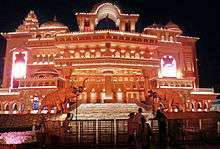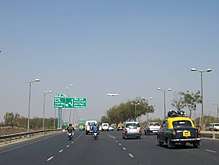Gurgaon
| Gurugram | |
|---|---|
| City | |
| Gurugram | |
 from top: DLF Gateway Tower, Gurugram city Skyline | |
| Nickname(s): Millennium city | |
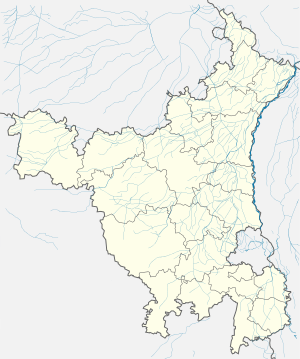 Gurgaon Location of Gurugram in Haryana  Gurgaon Gurgaon (India) | |
| Coordinates: 28°27′22″N 77°01′44″E / 28.456°N 77.029°ECoordinates: 28°27′22″N 77°01′44″E / 28.456°N 77.029°E | |
| Country |
|
| State | Haryana |
| District | Gurgaon district |
| Government | |
| • Body | Municipal Corporation of Gurugram |
| • Mayor | Madhu Azad |
| • MLA | Rao Narbir Yadav |
| • Lok Sabha constituency | Gurgaon Lok Sabha Constituency |
| • Vidhan Sabha constituency | Gurgaon City |
| • Planning agency | Gurugram Metropolitan Development Authority |
| Area | |
| • Total | 282.7 sq mi (732 km2) |
| Elevation | 711.9 ft (217 m) |
| Population (2011)[1] | |
| • Total | 876,900 |
| • Density | 3,100/sq mi (1,200/km2) |
| Languages | |
| • Official | Hindi |
| Time zone | UTC+5:30 (IST) |
| PIN | 122xxx |
| Area code(s) | 0124 |
| Vehicle registration |
HR-26 (City) HR-55 (Commercial) HR-72 (Sohna ) HR-76 Pataudi (Gurgaon) |
| Website |
www |
Gurgaon, officially named Gurugram is a satellite city of Delhi located in the northwestern Indian state of Haryana and is part of the National Capital Region of India. It is 32 kilometres (20 mi) southwest of New Delhi and 268 km (167 mi) south of Chandigarh, the state capital. As of 2011, Gurugram had a population of 876,900.[1]
Gurugram has become a leading financial and industrial hub with the third-highest per capita income in India.[2] The city's economic growth story started when the leading Indian automobile manufacturer Maruti Suzuki India Limited established a manufacturing plant in Gurugram (then Gurgaon) in the 1970s.[3] Today, Gurgaon has local offices for more than 250 Fortune 500 companies.[4] Gurgaon is a Yadav (also use title Rao) dominated place which used to hold most of agrarian land and political influence.[5][6][7][8]
History
The region of Gurugram originally fell under the Kuru Kingdom.[9]The earliest people to inhabit the city were Hindus of the Ahir clan.[10] Yadu tribes were a part of this clan and today their descendants commonly hold the last name Yadav. In the Mahabharata, Gurugram is described as the village of Guru Dronacharya, guru of the Kauravas and Pandavas.[11]In late 4th century BCE, the city was absorbed by the Maurya Empire as part of Chandragupta Maurya's earliest expansions of his kingdom.[12]
On 12 April 2016, Chief Minister of Haryana Manohar Lal Khattar announced a proposal to officially rename the city Gurugram (Sanskrit: गुरुग्राम, lit. village of the Guru), subject to the approval of the Haryana cabinet and the Union Government. He argued that the new name would help to preserve the "rich heritage" of the city by emphasising its history and mythological association with Dronacharya.[13][14][15] On 27 September 2016, Manohar Lal Khattar officially announced that the Union Government had approved the name change, and thus the city and district would henceforth be known as Gurugram.[16]
Despite the official renaming, "Gurgaon" has still remained in colloquial use throughout the city. While some entities do publicly use "Gurugram", a large number of businesses have continued to use "Gurgaon" in their addresses or signage.[17]
Geography
Gurugram is located in Gurgaon district in the Indian state of Haryana and is situated in the southeastern part of the state, and northern part of the country. The city is located on the border with Delhi with New Delhi to its northeast. The city has a total area of 738.8 square kilometres (285.3 sq mi)[18]
Topography
The average land elevation is 217 metres (712 ft) above sea level.[19]
Climate
Under the Köppen climate classification, Gurugram experiences a monsoon-influenced Composite climate .[20] The city experiences four distinct seasons - spring (February - March), summer (April - August), fall/autumn (September - October) and winter (November - January), along with the monsoon season setting in towards the latter half of the summer. Summers, from early April to mid-October, are typically hot and humid, with an average daily June high temperature of 40 °C (104 °F). The season experiences heat indices easily breaking 43 °C (109 °F). Winters are cold and foggy with few sunny days, and with a December daytime average of 3 °C (37 °F). The Western Disturbance brings some rain in winters that further adds to the chill. Spring and autumn are mild and pleasant seasons with low humidity. The monsoon season usually starts in the first week of July and continues till August. Thunderstorms are not uncommon during the Monsoon. The average annual rainfall is approximately 714 millimetres (28.1 in).[20]
| Climate data for Gurgaon | |||||||||||||
|---|---|---|---|---|---|---|---|---|---|---|---|---|---|
| Month | Jan | Feb | Mar | Apr | May | Jun | Jul | Aug | Sep | Oct | Nov | Dec | Year |
| Average high °C (°F) | 21.1 (70) |
24.2 (75.6) |
30.0 (86) |
36.2 (97.2) |
39.6 (103.3) |
39.3 (102.7) |
35.1 (95.2) |
33.3 (91.9) |
33.9 (93) |
32.9 (91.2) |
28.3 (82.9) |
23.0 (73.4) |
31.4 (88.5) |
| Average low °C (°F) | 7.3 (45.1) |
10.1 (50.2) |
15.4 (59.7) |
21.5 (70.7) |
25.9 (78.6) |
28.3 (82.9) |
26.6 (79.9) |
25.9 (78.6) |
24.4 (75.9) |
19.5 (67.1) |
12.8 (55) |
8.2 (46.8) |
18.8 (65.8) |
| Average rainfall mm (inches) | 20.3 (0.799) |
15.0 (0.591) |
15.8 (0.622) |
6.7 (0.264) |
17.5 (0.689) |
54.9 (2.161) |
231.5 (9.114) |
258.7 (10.185) |
127.8 (5.031) |
36.3 (1.429) |
5.0 (0.197) |
7.8 (0.307) |
797.3 (31.389) |
| Average rainy days | 1.7 | 1.3 | 1.2 | 0.9 | 1.4 | 3.6 | 10.0 | 11.3 | 5.4 | 1.6 | 0.1 | 0.6 | 39.1 |
| Mean monthly sunshine hours | 213.9 | 217.5 | 238.7 | 261.0 | 263.5 | 198.0 | 167.4 | 176.7 | 219.0 | 269.7 | 246.0 | 217.0 | 2,688.4 |
Demographics
The Gurugram municipal corporation area has an estimated population of 876,900, according to the 2011 Census of India.[1]
Cityscape
Architecture
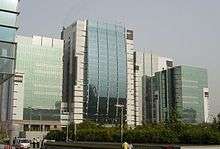
Gurugram has architecturally noteworthy buildings in a wide range of styles and from distinct time periods. Gurugram skyline with its many skyscrapers is nationally recognised, and the city has been home to several tall buildings with modern planning. Gurugram has an estimated 1,100 residential high-rises.[21] The average cost of a 93-square-metre (1,000 sq ft) two-bedroom apartment at a decent condominium in Gurugram is at least $160,130 (₹10,000,000).[21]
Neighbourhoods
Gurugram is divided into 36 wards, with each ward further divided into blocks. The housing type in the city consists largely of attached housing, though a large number of attached multi-dwelling units, including apartments, condominiums and high rise residential towers are getting popular.
Parks
Gurugram has a complex park system, with various lands operated by the Gurugram Metropolitan Development Authority. The key parks are Leisure Valley Park in Sector 29, which is spread over 15 hectares (36 acres); Tau Devi Lal Biodiversity Botanical Garden in Sector 52; Netaji Subhash Chandra Bose Park in Sector 14, popularly known as HUDA Garden; Tau Devi Lal park in Sector 23; and Aravali Biodiversity Park on MG Road. However, most of the parks in Gurugram are small and ill-maintained.[22]
Culture
Entertainment and performing arts
Notable performing art venues in the city include Epicentre in Sector 44 and Nautanki Mehal at the Kingdom of Dreams near IFFCO Chowk. Bollywood actor Rajkummar Rao was born in Gurugram .
Languages and dialect
The main language spoken in Gurugram is Hindi, though a segment of the population understands and speaks English. The dialect used in Hindi is similar to that of Delhi, and is considered neutral, though the regional influences from the states of Haryana, Uttar Pradesh and Punjab adds an accent to the language. English is spoken with an Indian accent, with a primarily North Indian influence. Since Gurugram has a large number of international call centres, the employees are usually given formal training in neutral pronunciation in order to be understandable to native English speakers. Haryanvi and Punjabi are other popular languages spoken in the city. The other regional languages include Mewati and Haryanvi.[23][24]
Religion
Hinduism is a predominant religion among the city's population. Gurugram also includes adherents of Sikhism, Islam, Buddhism, Jainism, Christianity and the Bahá'í, among others. There are several places of worship for major religions in Gurugram , including mandirs, gurdwaras, mosques and churches.
Sheetla Mata Mandir is a famous temple located in Village Gurgaon district Gurugram of Haryana state of India. It is a temple dedicated to the wife of Guru Dronacharya.[25] The temple hosts fairs regularly and a huge number of people come to seek blessings of Sheetla Mata every year.
Sports
The city has two major sports stadiums: Tau Devi Lal Stadium in Sector 38, which has facilities for cricket, football, basketball and athletics as well as a sports hostel, and Nehru Stadium which is designed for football and athletics. Amity United FC is a tenant of Tau Devi Lal Stadium. Gurugram district has nine golf courses, and is described as the "heart of India's golfing country".[26] Joginder Rao, a domestic cricket player was from Gurugram .
Economy
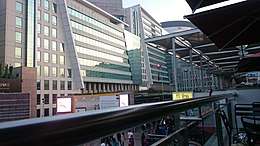
Gurugram has the third-highest per-capita income in India,[2][27] and is the site of Indian offices for half of Fortune 500 companies. The city also benefits from its close proximity to Delhi. Maruti Suzuki Private Limited was the first company that set up a manufacturing unit in the city in 1970s making cars.[3] Eventually, DLF Limited, a real estate company acquired vast stretches of land in the city. The first major American brand to set up a unit in Gurugram was General Electric in 1997. GE's setup in Gurugram prompted other companies, both international as well as domestic, to follow suit.[28] providing outsourcing solutions in software, IT, service and sales through delivery facilities and call centres. However, due to the lack of proper public transport and the inability of most of the employees to afford a personal vehicle, most of the call centres provide pooled-in cars to and from their offices.[28] Apart from Business process outsourcing and IT sectors, the city is home to several other companies that specialise in domain expertise. Siemens Industry Software, in Gurugram Business Park, made a portfolio of design software that was used by NASA to digitally design, simulate and assemble the vehicle before any physical prototypes were built.[28] Various international companies, including Coca-Cola, Pepsi, BMW, Agilent Technologies, Hyundai have chosen Gurugram to be their Indian corporate headquarters.[28] All the major companies in the city depend on their own backup, given the fact that Gurgaon does not have reliable power and water supply, public transport and utilities. Retail is an important industry in Gurugram , with the presence of 26 shopping malls.[29] Real estate is a major force in the city's economy. Gurgaon is home to some of the nation's most valuable real estate.
All Nippon Airways, a Japanese airline, maintains its Delhi sales office in the Time Tower in Gurugram .[30]
Law and government
Gurugram is governed by the Municipal Corporation of Gurugram which follows a Mayor-Council system.[31]. In 2017 , GMDA (Gurugram Metropolitan Development Authority) was formed. GMDA looks after the Infrastructure and also has improved a lot of city's infrastructure.
Crime
The law and order situation in Gurugram is below par and has been deteriorating for the past few years with a sharp increase in the number of homicides, rapes and thefts. The city reported 89 homicides in 2012. Another growing concern is an increase in the number of rapes, robberies, assaults, burglaries, and thefts, including motor vehicle thefts. The total vehicle thefts registered by the police in Gurugram in 2014 was 3,638.[32]
The police department in Gurugram is headed by the Commissioner of Police - Gurugram Police, which forms a part of the Haryana Police.[33] and reports to the Haryana state government. Sandeep Khirwar (IPS) is the Commissioner of Police in Gurgaon. Gurugram Police has a separate traffic police department headquartered in sector 51.[34] Fire protection within the city limits is provided by Municipal Corporation of Gurugram through four fire stations, located in sector 29, sector 37, Udyog Vihar and Bhim Nagar.[35]
Education


The city's public school system is managed by the government of Haryana, and administered by Haryana Board of School Education.
There are several universities and institutes located in Gurugram and the surrounding area, including newly established Gurugram University, Sushant School of Art and Architecture & Ansal Institute of Technology, Sector 55; ITM University, Sector 23A; GD Goenka University, Sohna Road; KR Mangalam University, Sohna Road; Amity University, Gurgaon, Manesar; Apeejay Stya University, Sohna; BML Munjal University, NH8; Shree Guru Gobind Singh Tricentenary University, Budhera;[36] and National Brain Research Centre, Manesar.
Transport
Roadways
The major highway that links Gurugram is National Highway 48, the road that runs from Delhi to Mumbai. While the 27.7-kilometre (17.2 mi) Delhi-Gurugram border-Kherki Dhaula stretch has been developed as an expressway, the rest is expanded to six lanes.[37]
Railways
Intercity rail
Gurgaon railway station is operated by Northern Railway of Indian Railways. The rail station forms a part of the larger Indian Railways network. Along with that, Gurugram has Dhankot railway station, Ghari Harsaru Railway Junction and Farrukhnagar Railway Station, Patli Railway Station. Under Modernisation of Railway Station, Indian Railway is modernising four railway stations in Gurugram. Gurgaon Railway Station, Ghari Harsaru Railway Junction and Farrukhnagar Railway Station will be developed and modernised with modern amenities and international facilities.
Delhi Metro
.jpg)
There are five stations served by Delhi Metro Rail Corporation Ltd. located on the Yellow Line, which are HUDA City Centre, IFFCO Chowk, MG Road, Sikanderpur and Guru Droncharya.
Rapid Metro
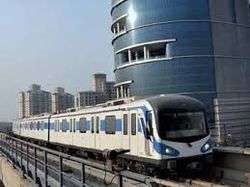
Rapid Metro has eleven stations in Gurugram , with an interchange with Yellow Line of Delhi Metro at Sikandarpur metro station. The Rapid Metro became operational in November 2013 and currently covers a distance of 11.7 kilometres (7.3 mi).[38] One more phase of the project are in the pipeline and would take the total number of subway stations in the city to 16. An estimated 33,000 people ride Rapid Metro every day, which provides an exclusive elevated transit service with three coach trains that run in a loop.[39]
Airways
Airport
Gurugram is served by Delhi's Indira Gandhi International Airport, which is located just outside of Gurugram city limits near National Highway 8.
Transit systems
Public transit
In November, 2013, Gurugram launched an Ciclovia-inspired initiative known as Raahgiri Day—in which a corridor of streets are closed to motor vehicle traffic on Sunday mornings to encourage the use of non-motorized transport and participation in outdoor leisure activities. Gurugram was the first city in India to implement such a program, followed by New Delhi, and later Noida.[40][41][42]
Gurugram is also expected to get India's first Pod Taxis.[43]
Utilities
Electricity in Gurugram is provided by government-owned Dakshin Haryana Bijli Vitran Nigam. Gurugram has power consumer base of 360,000 with average power load of 700-800 MW.[44] There are frequent power outages in the city, especially during the peak consumption season of summer. Apart from the power deficit, the equipment used by the power department like transformers, panels and transmission lines is either old or overburdened.[45]
Issues
Flooding
Gurugram is notorious for its urban floods every monsoon.[46] The areas on NH-8 around Hero Honda Chowk, Basai, Dhankot, sector 37 etc. see massive urban floods and headlines grabbing traffic jams reported widely in news media. A recent research report puts the blame on the broken natural water body linkage and obstructions in the flow in the city due to frantic construction during the last decades.[47]
Gurugram's Ghata Jheel, Badshahpur Jheel, Khandsa Talab were linked to Najafgarh drain which links to Yamuna river, via natural water channels and drains.[47]
As per the ground reports and research, the three natural water bodies are struggling for their existence with encroachments on their lands and natural channels. Agencies responsible have tried to create artificial water bodies to compensate,[48] but the efforts fail due to unpredictable rain and water flow patterns leading to deployment of water pumps to fight the situation.
In 2012 Punjab & Haryana High court banned ground water usage for construction activity,[49] and NGT has recently reprimanded authorities for drain concretization.[50]
See also
References
- 1 2 3 "Cities having population 1 lakh and above, Census 2011" (PDF). censusindia.gov.in. Retrieved 5 July 2015.
- 1 2 Julka, Harsimran (30 September 2011). "IT firms looking beyond Gurgaon, Noida, Greater Noida to other cities in north India". The Economic Times. ET Bureau. Retrieved 2 October 2013.
- 1 2 Kumar, K.P. Narayana. "Gurgaon: How not to Build a City". Forbesindia.com. Retrieved 2 October 2013.
- ↑ "Jat stir shakes India Inc". Retrieved 2016-02-22.
- ↑ https://findery.com/sandeepnaharia/notes/rewari-haryana-part-of-ahirwal-abode-of-ahirs-yadav-desendent-of-lord-krishna-and-ancient-king-yadu
- ↑ http://www.dailypioneer.com/state-editions/chandigarh/constituency-wise-analysis.html
- ↑ http://www.dnaindia.com/locality/gurgaon/haryana-assembly-election-results-gurgaon-district-becomes-saffron-stronghold-44709
- ↑ http://zeenews.india.com/news/haryana/ahirwal-belt-is-represented-well-in-khattar-ministry_1489879.html
- ↑ The History of India. The Rosen Publishing Group, Inc, 2010. p. 63. ISBN 1615301224.
- ↑ "History | Gurugram". gurugram.gov.in. Retrieved 2018-09-14.
- ↑ "Gurgaon to Gurugram: How the epic 'Mahabharata' inspired Haryana govt to change millennium city's name". 2016-04-13. Retrieved 2018-09-14.
- ↑ Constance Jones; James D. Ryan (2006). Encyclopedia of Hinduism. Infobase Publishing. p. xxviii. ISBN 978-0-8160-7564-5.
- ↑ "Gurgaon is now 'Gurugram', Mewat renamed Nuh: Haryana government". The Indian Express. 12 April 2016. Retrieved 12 April 2016.
- ↑ "Welcome to the new office of Gurugram police commissioner". Hindustan Times. Retrieved 5 May 2016.
- ↑ "Gurgaon: The city whose middle name is paradox". The Times of India. Retrieved 12 July 2016.
- ↑ "Good morning, Gurugram. The name's official". The Times of India. Retrieved 3 December 2016.
- ↑ "A year after renaming, 'Gurgaon' still lives on - Times of India". The Times of India. Retrieved 2017-11-10.
- ↑ "Demographics". Municipal Corporation, Gurgaon.
- ↑ "GGN/Gurgaon(3)". India Rail Info. Retrieved 2 October 2013.
- 1 2 "Travel Info". The Metropolitan Hotel and Spa New Delhi. Archived from the original on 1 October 2013. Retrieved 2 October 2013.
- 1 2 Anand, Deevakar (10 May 2013). "Gurgaon's better than Delhi, but way behind Shanghai". Retrieved 3 October 2013.
- ↑ "How green was Gurgaon's parks". The Times of India. TNN. 30 December 2011. Retrieved 2 October 2013.
- ↑ "Culture and Languages". Stay IN Gurgaon.com. Stay IN Gurgaon.com. Archived from the original on 27 July 2014. Retrieved 20 July 2014.
- ↑ "Travel Info". Hotel Sun Villa. Archived from the original on 28 July 2014. Retrieved 20 July 2014.
- ↑ "Sheetla Mata Mandir Gurgaon". sheetlamatagurgaon.com. Archived from the original on 25 February 2016. Retrieved 1 March 2016.
- ↑ Singh, Prabhdev. "Golf courses in Gurgaon". HT Media. Live Mint. Retrieved 3 May 2015.
- ↑ "UK minister inaugurates business centre in Gurgaon". The Times of India. TNN. 20 September 2013. Retrieved 3 October 2013.
- 1 2 3 4 Kannan, Shilpa. "Gurgaon: From fields to global tech hub". BBC News. Retrieved 4 October 2013.
- ↑ "Gurgaon as IT outsourcing hub". Amit Arun and Associates. Retrieved 5 October 2013.
- ↑ "Contact ANA." ANA India. Retrieved on July 9, 2016. "Unit No.302 & 303, 3rd floor, Time Tower, Sector 28, MGRoad, Gurgaon 122 002 India" - See map "Time Tower 3rd floor"
- ↑ Joseph, Joel (22 June 2011). "Gurgaon gets first mayor after month's wait". The Times of India. TNN. Retrieved 5 October 2013.
- ↑ Behl, Abhishek (20–26 February 2015). "Your car could be next" (Guragaon). 'Friday Gurgaon. FG. Retrieved 26 February 2015.
- ↑ "Gurgaon Police". Gurgaon Police, Govt. of Haryana. Retrieved 24 October 2013.
- ↑ "Gurgaon police". Gurgaon Police, Govt. of Haryana.
- ↑ "Gurgaon's fourth fire station opens in Udyog Vihar". Bennett, Coleman & Co. Ltd. TNN. 16 April 2012. Retrieved 24 October 2013.
- ↑ "Universities & Colleges". University Grants Commission. Retrieved 11 October 2013.
- ↑ Dash, Dipak Kumar (7 December 2012). "NH48 stretch on Delhi-Gurgaon border is India's deadliest road". The Times of India. TNN. Retrieved 11 October 2013.
- ↑ Joseph, Joel (13 November 2013). "From tomorrow, Gurgaon will finally have its Rapid Metro". The Times of India. TNN. Retrieved 13 November 2013.
- ↑ ASHOK, SOWMIYA (16 June 2014). "Are Gurgaon residents game for a smooth ride on the Rapid Metro?". The Hindu. Retrieved 18 June 2014.
- ↑ "New area in Gurgaon to have 'Raahgiri Day'". Business Standard. IANS. 27 February 2014. Retrieved 17 March 2014.
- ↑ fwire (27 February 2014). "New area in Gurgaon to have 'Raahgiri Day'". Firstpost. IANS. Retrieved 28 November 2014.
- ↑ "Raahgiri: Less honking, more bonding — How Gurgaon showed the way". Times of India. Retrieved 15 April 2016.
- ↑ "India's First Pod Taxis Are Coming Up In Gurgaon And The Rs 850 Crore Project Begins Next Month". Retrieved 12 December 2016.
- ↑ "Essar withdraws application for distribution licence in Gurgaon". PTI. 22 October 2013. Retrieved 25 October 2013.
- ↑ "Night-long outage in Old Gurgaon as transformer trips on demand". The Times of India. TNN. 24 May 2014. Retrieved 10 June 2014.
- ↑ "Traffic nightmare in Gurgaon; waterlogging on NH8 hits Delhi-Jaipur route, schools shut". Zee News. 2016-07-29. Retrieved 2017-02-16.
- 1 2 "Why Gurgaon Floods, a report on watershed management and imminent dangers the city faces". Why Gurgaon Floods, a report on watershed management and imminent dangers the city faces. (in Hindi). 2016-07-11. Retrieved 2017-02-16.
- ↑ "Huda to speed up construction of additional discharge drain under service road of NH-8 - Times of India". The Times of India. Retrieved 2017-02-16.
- ↑ "Gurgaon builders left high and dry". Retrieved 2017-02-16.
- ↑ "NGT seeks report on drawbacks and impact of concretization of natural drains". Hindustan Times. 2017-02-01. Retrieved 2017-02-16.
Further reading
- Basi, J.K. Tina (2009), Women, Identity and India's Call Centre Industry, Oxford: Routledge, ISBN 978-0-203-88379-2, retrieved 12 November 2013
- Gururani, Shiva (1 March 2013), "Flexible Planning: The Making of India's 'Millennium City', Gurgaon", in Anne M. Rademacher, Ecologies of Urbanism in India: Metropolitan Civility and Sustainability, K. Sivaramakrshnan, Hong Kong University Press, pp. 119–, ISBN 978-988-8139-77-4
- Narain, Vishal (2009), "Growing city, shrinking hinterland: land acquisition, transition and conflict in peri-urban Gurgaon, India", Environment and Urbanization, 21 (2): 501–512, doi:10.1177/0956247809339660
- Pagnamenta, Robin (6 July 2012), "Indians riot over water shortages and power cuts", The Times, London, retrieved 12 November 2013, (Subscription required (help))
- Rich, Nathan (2013), "Globally integrated/locally fractured: the extraordinary development of Gurgaon, India", in Peggy Deamer, Architecture and Capitalism: 1845 to the Present, London: Routledge, pp. 172&ndash, 188, ISBN 978-1-135-04954-6, retrieved 12 November 2013
- Yardley, Jim (6 September 2011), "In Gurgaon, India, Dynamism Wrestles With Dysfunction", The New York Times, retrieved 12 November 2013, (Subscription required (help))
External links
| Wikimedia Commons has media related to Gurgaon. |

- "Gurgaon: Model City and Cautionary Tale, Slide Show", The New York Times, retrieved 12 November 2013
- "India Rising, Off-the-Grid: Video", The New York Times, retrieved 12 November 2013
